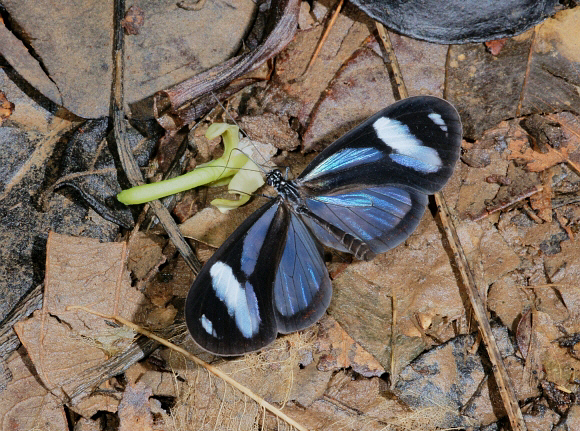
Introduction
The Ithomiini comprises of 376 known species, although it is likely that at least another 30 will be discovered in the near future. All are confined to the neotropical region. Ithomiines are unpalatable to birds, and are consequently mimicked in appearance by many other species. These include other unpalatable species ( Müllerian mimics ), not only from the Ithomiinae but also from several other butterfly families. There are also a large number of edible species ( Batesian mimics ) which have evolved similar patterns. Birds have the ability to memorise butterfly patterns and so learn to avoid eating noxious species, but are also fooled into ignoring similarly marked edible species.
Ithomiines are characterised by having small eyes, slender abdomens and long drooping antennae that lack distinct clubs. Males have a plume of long androconial scales or “hair pencils” on the costa of their hindwings. These are hidden from view when the butterflies are at rest, but are displayed when the wings are held open during courtship. Other Ithomiine characteristics include a very slow and deep wing beat, and a preference for inhabiting the darkest recesses of the forest understorey.
There are basically 2 types of Ithomiine. The first type are the black and orange-banded “tigers”, many of which are mimicked by other species due to their unpalatability to birds. The second type are the “glasswings”, recognised by their transparent or translucent wings, prominent veins, and orange wing margins. Many genera contain examples of both of these types, and in some cases an individual species may produce adults of both forms according to location.
Most novices find the Ithomiini very difficult to identify. Using only the patterns to identify species is very unreliable because there are so many similar species. Also many species produce a variety of different colour forms according to locality and season. The best approach therefore is to use the hindwing venation and other anatomical features to identify the genus, and to then look at the wing patterns to short-list the likely species.
There are 8 species in the genus Hyposcada. Males can be distinguished from other genera by the presence of a short narrow strip of androconia along the lower edge of the forewing.
Hyposcada illinissa is found from Colombia to Bolivia.
Habitats
The butterfly occurs in lowland rainforest at altitudes between about 100-1100 metres.
Lifecycle
The only recorded information about the early stages of this genus is that Hyposcada virginiana was claimed by Haber to oviposit on Columnea and Drymonia ( Gesneriaceae ). This seems questionable however as the use of plants in this family is very unusual for any Lepidoptera, and not known in any other Ithomiine species.
Adult behaviour
Hyposcada illinissa is usually seen singly or in small groups. The butterflies spend a lot of their time sitting motionless on the foliage of saplings and bushes at a height of about 2m above ground level, but can sometimes be seen in light gaps, fluttering around fallen petals on the forest floor. In Peru at Rio Alto Madre de Dios for example I watched a male feeding on fallen petals on the forest floor. It was oblivious of my presence but when deliberately disturbed it flew up to settle on the foliage of a sapling. Minutes later it returned to resume feeding at the petals. It was unclear whether it was obtaining nectar, or sequestering pyrrolizidine alkaloids, a behaviour that DeVries states is unknown in this genus.
